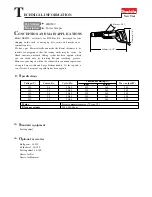
Keep fingers out of reach of the inserted tool or accessory.
The use of safety-/working gloves is recommended.
Use ear protection as instructed by your employer or as required by occupational health and safety requirements.
Reasonable countermeasures have to be taken to keep the noise level as low as possible.
Disconnect the air supply before changing inserted tools, accessories, repairs or when the tool is not being used.
Always check that the mounted tool or accessory is not damaged. Breakage and flying fragments can cause injuries.
In case of long hair, wear a hairnet otherwise it can be trapped causing injuries.
Never wear loose clothing, wear suitable clothing otherwise it can be trapped causing injuries.
Only use accessories for this tool that are designated for this tool by its manufacturer.
Convince yourself that no persons are in the working zone or danger zone.
The advised minimum age for operating this tool is 18 years.
Keep away from whipping hoses, this can cause injuries. A broken air hose or a hose that comes loose of the hose joint can start
whipping. Shut down the air supply immediately. In case the air hose is damaged, stop working, shut down the air supply and replace
the hose.
Keep the work place clean and organized, you may stumble and fall over a hose on the floor. Slippery floors and objects on the floor
are major causes of injuries.
This tool is not intended for use in potential hazardous areas and is not insulated from coming into contact with electric power.
In case that during the use of this tool dust is generated by either the process or the exhaust air blowing on dust in the environment, a
risk assessment has to made. Operator must use appropriate protection to prevent inhalation or skin contact. According to health and
safety regulations dust suction systems should be useded if possible and be maintained according manuafacturer's instructions.
Wear the appropriate clothing to feel comfortable at the workplace.
Cold exhaust air should be diverted from hands and body.
Air under pressure can cause injuries, be aware of this.
Never direct the exhaust air to yourself or anyone else.
Do not use quick change couplings direct on the air inlet of the tool as these may release during operation. Assemble at least 50 cm
air hose with a hose joint of shock resistant material.
In case universal twist couplings ( claw couplings) are used, the lock pins must be mounted.
Do not exceed the maximum air pressure as indicated on the tool.
Never carry the tool by the air hose.
On overhead work, use safety helmet.
Due to the process, the work piece, inserted/mounted tool/accessory may get hot causing burning injuries: Be aware of this.
Only use air hoses that are designed for it and are resistant against the used air pressure.
Always use "safety quick change couplers".
Never let the tool run free in the air: the accessory may come loose and become a projectile causing danger or injury
Only use accessories that are in good condition, worn accessories can be dangerous and cause injuries.
Only trained and qualified operators should use the tool.
Never use a damaged tool.
Tools shall be inspected periodically to verify that the ratings and markings required by the applicable part of the ISO 11148 series are
legibly marked on the tool. If not the user/employer shall obtain replacement labels from the dealer or manufacturer.
Use only tight fitting gloves, loose gloves can be trapped or entangled causing injuries.
Use the specified gloves for the application that protects against: heat, cold, entanglement, cutting, impacting
Do not wear any shawls jewelry etc that can be trapped or entangled causing injuries.
In case of power loss, release the trigger immediate.
Make the possible countermeasures to minimize noise emission: if possible, use silence materials on the workpiece or walls around the
work station.
A risk assessment related to the noise emission at the work station on the work piece has to be made to determine the correct ear
protection according to health and safety regulation.
A risk assessment related to the vibration exposure to determine the maximum working hours per day for the operator. Vibration can
cause damage to blood vanes and nerves (white finger disease). Hold the tool with light but safe grip, higher grip force can increase
vibration effects.
Whipping air hoses can cause injuries. Always check if air hose is damaged and that the fittings and couplings are not loose.
Use only hardened steel hose fittings (or same strength other fittings) for impact, impulse or vibrating tools.
Accessories
Only use accessories and consumables that are designed for the use with this tool.
Select the best available inserted/mounted accessories/consumables for the lowest possible noise level and vibration. Replace them in
case of an increased noise level and/or vibration.
Make sure that the inserted/mounted tool/accessory is properly held by the retainer and make sure that the retainer is in good
condition. Never use the tool without a retainer as this may cause high speed projectiles.
Only use sharp chisels, as blunt chisels require excessive pressure and can break.
Never cool down a hot tool/accessory as this may influence the hardness causing dangerous circumstances.
Use the inserted/mounted accessory/tool according to the manufacturer specifications.
Never use a chisel as lever as this can cause brakeage.
DO NOT operate the hammer freely, It must always be in contact with the work surface. Failure to do so can cause Retainer, Cylinder
or housing failure which may result in injury to the operator and will invalidate warranty .
Summary of Contents for TOKU TCD-20
Page 1: ... TCD 20 MANUAL EN www rami yokota com ...
Page 2: ......
Page 7: ... www rami yokota com ...

























